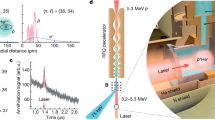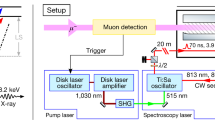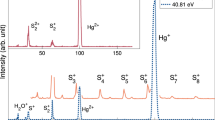Abstract
THE possibility of obtaining samples of helium in which the isotope of mass 3 has been enriched allows the isotope shifts in the arc spectrum of this element to be investigated. The first samples, which had kindly been made available to us by Dr. Rollin and Mr. Hatton1, had been prepared by means of thermal diffusion, and contained helium-3 in a concentration of 1 : 700. With an ordinary Fabry Pérot étalon, the detection of satellites several hundred times weaker than the main line is impossible, owing to the finite background intensity of this instrument. This difficulty was overcome by the use of two étalons, of equal spacings, in series. By suitable choice of apertures, distances and orientations of the wedge-shaped étalon plates, it was found comparatively easy to avoid secondary reflexions. The method appears to be very useful for the investigation of faint satellites very close to strong lines.
This is a preview of subscription content, access via your institution
Access options
Subscribe to this journal
Receive 51 print issues and online access
$199.00 per year
only $3.90 per issue
Buy this article
- Purchase on Springer Link
- Instant access to full article PDF
Prices may be subject to local taxes which are calculated during checkout
Similar content being viewed by others
References
Rollin, B. V., and Hatton, J., Phys. Rev. (in the press).
Hughes, D., and Eckart, C., Phys. Rev., 36, 694 (1930).
Eckart, C., Phys. Rev., 36, 878 (1930).
Author information
Authors and Affiliations
Rights and permissions
About this article
Cite this article
BRADLEY, L., KUHN, H. Spectrum of Helium-3. Nature 162, 412–413 (1948). https://doi.org/10.1038/162412b0
Issue Date:
DOI: https://doi.org/10.1038/162412b0
This article is cited by
-
Isotopic spectral analysis of helium with the aid of an isotope filter
Journal of Applied Spectroscopy (1966)
Comments
By submitting a comment you agree to abide by our Terms and Community Guidelines. If you find something abusive or that does not comply with our terms or guidelines please flag it as inappropriate.



